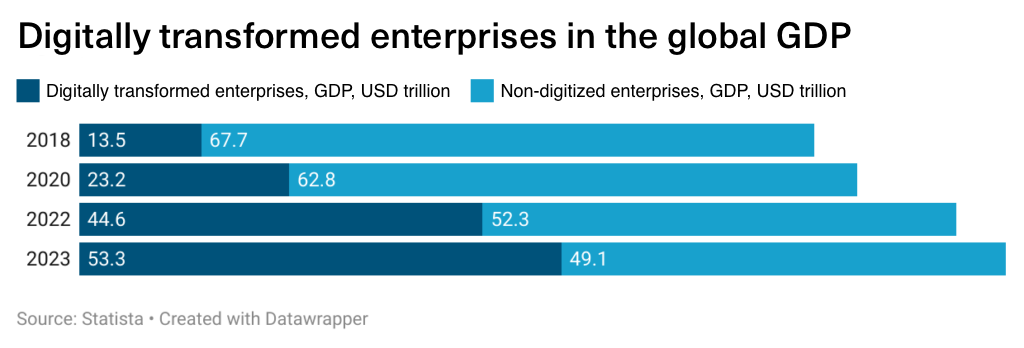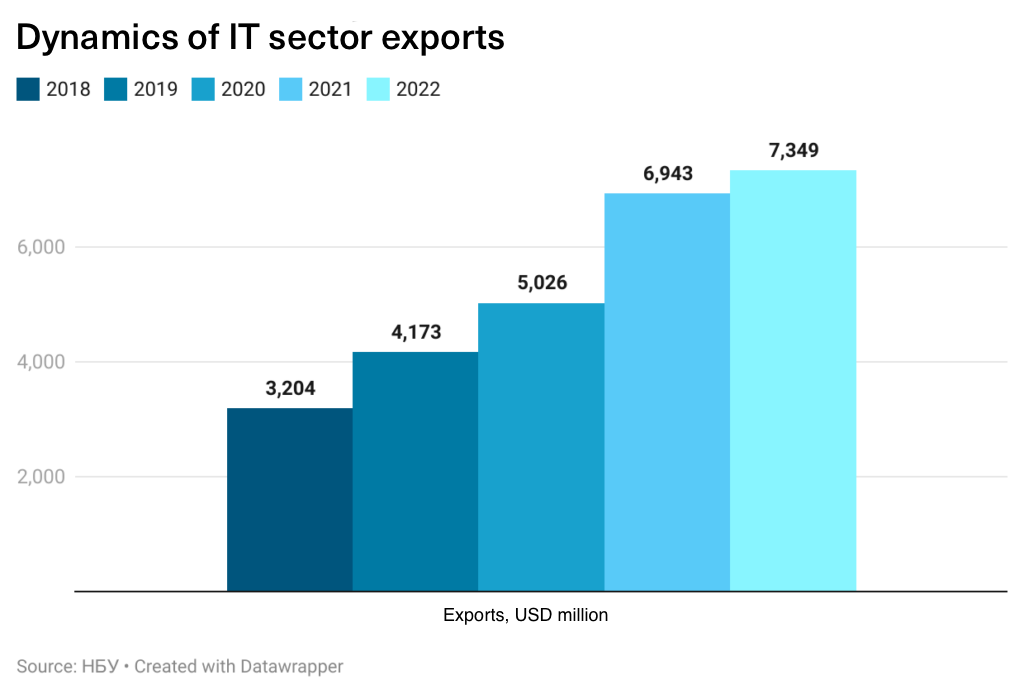This year, the share of digitally transformed enterprises in the global GDP will exceed 50%. How can Ukraine keep up with the development of the digital economy compared to developed countries? What state policy measures can assist in this?
The digital economy is all economic activity facilitated through the use of information and communication technologies and other digital technologies. It encompasses not only IT developments and scientific digital solutions but also electronic commerce, online services, and outcomes of digitized enterprises.
According to forecasts, around 70% of created value will be based on digital products in the coming decade. If, in 2018, the share of the global GDP attributed to digitally transformed enterprises was $13.5 trillion, by 2023, this figure is projected to reach $53.3 trillion (which is nearly four times higher), constituting more than half of the nominal global GDP (Figure 1).
Figure 1.
The digital economy can become a factor of economic resilience and a reliable source of tax revenue, as it is less dependent on physical assets compared to industries like manufacturing or agriculture. The stability of the digital sector is most noticeable during times of crisis. Following the onset of the full-scale invasion, the Ukrainian IT industry became one of the most stable sectors of the economy, being the only sector whose export volume increased in 2022.
Information technology has the potential to significantly enhance the efficiency of future reconstruction processes. This involves not only the development of the IT sector and the application of digital technologies in other industries to boost production efficiency but also digital solutions for the distribution of international aid and monitoring its utilization. This will help reduce corruption risks.
How to support the development of the digital economy? According to research, the main factors contributing to its development are a well-developed field of information and communication technologies (ICT), strong educational institutions, and competitive innovations.
Information technologies form the basis of digital transformation for enterprises. The development of technologies such as artificial intelligence, big data, and the Internet of Things increasingly influences business processes. In turn, scientific research and development are the foundation for creating information technologies and other digital products that enterprises subsequently utilize. And for R&D, a scientific and educational environment is needed, which fosters the emergence of capable researchers and engineers and promotes innovation.
Which of the three factors for successful digital economy development are present in Ukraine, and in which areas do we still need to invest our efforts?
Information and Communication Technologies sector
Based on the outcomes of the year 2022, the sector contributed $7.35 billion or 4.5% of the GDP to Ukraine’s economy (Figure 2). The number of companies and enterprises in Ukraine providing digital services is approximately 8,200, with around 5,000 actively seeking new employees and about 1,500 companies being technological startups. According to DOU data, as of the end of February 2023, there were 271,699 individual entrepreneurs (IEs) working in the IT sector, accounting for 13.6% of active IEs during that period (although some of these entrepreneurs might actually be employed workers, it still constitutes a significant portion).
Figure 2.
The development of the ICT sector is largely determined by the societal demand for its products and services. To foster this demand, both digital infrastructure (such as mobile coverage and broadband internet) and a high level of digital skills among the population are essential. In Ukraine, these skills are mainly concentrated among the younger population. For instance, even though there were 49.3 million active mobile communication subscriptions by the end of 2022, of which 35.4 million (72%) were connected to mobile internet, among individuals over the age of 60, only 32% use the internet daily, while 48% do not use it at all. As a result, a significant portion of the population cannot utilize services like booking doctor appointments electronically or using Diia services. Consequently, digital inequality has become another inequality dimension requiring the government’s attention.
Research and development
Unlike the ICT sector, the Ukrainian science and innovation sector situation is less optimistic. Today, Ukraine ranks at the “tail end” of innovation rankings. For example, in the Global Innovation Index (2022), Ukraine holds 34th out of 39 European countries, and in the World Digital Competitiveness Ranking (2021), it ranks 54th out of 64 countries. The reasons for this include insufficient funding for scientific research, inefficient organization of the scientific sector, as well as issues with protecting intellectual property. Despite progress in recent years, this indicator received one of the lowest scores in the UN E-Participation Index for 2022. This partially explains Ukraine’s low patent activity. According to data from WIPO (World Intellectual Property Organization), Ukraine registered 1,706 patent applications in 2021, while the average value in European countries was 12,680 and 4,010 in Eastern European countries.
Another unresolved issue is the funding for implementing the developments into real-world applications, especially for startups. Most developed countries have the infrastructure to take an innovative idea to a market-ready product. This infrastructure includes venture capital funds, government and private grants, crowdfunding, and more. In Ukraine, such infrastructure is quite underdeveloped – for instance, crowdfunding is not even recognized in legislation.
Education
Education in the field of information and digital technologies lags behind the demands of the market. That’s why IT companies are implementing joint educational programs with universities or offering their own training courses. Approximately 20% of IT industry employees do not have higher education (they either completed courses or learned directly on the job), and 50% of them, in addition to higher education, received informal education related to their field (courses, webinars, etc.). However, for individuals to rise beyond the level of an ordinary programmer, they require quality fundamental training, which can only be provided by higher education institutions. Therefore, the modernization of educational programs is needed (not just in the IT field, but this is a topic for a separate article).
Furthermore, there’s a need to transition from the Soviet-era separation of science and education (research institutes and universities) to the Western model, in which universities are the main centers of scientific development. The first step towards this should be universities’ academic and financial autonomy.
Conclusions and recommendations
The digital economy sector in Ukraine has the potential to provide stability and growth in necessary financial revenues, especially for post-war reconstruction. Digital solutions represent not only a financial interest but also a strategic one, as they can enhance the efficiency of the industries they integrate into, including government and military sectors.
The foundation of the digital economy consists of information technologies, education, science, and innovation. For their development, the following are necessary:
- Establishing a legislative framework to regulate issues related to alternative sources of funding. Simplifying procedures for attracting non-governmental funding for universities and research institutions.
- Reforming higher education, including increasing the autonomy of universities and updating educational programs to align with the demands of the job market.
- Enhancing the basic digital skills of the population through state-subsidized courses (for example, such studies could be administered by State Employment Centers).
- Implementing local government projects for digitization (digital communities), particularly focusing on developing digital infrastructure tailored to the needs of each community.
- Continuing reforms in the field of intellectual property protection, including harmonizing Ukrainian legislation with EU norms.
Attention
The author doesn`t work for, consult to, own shares in or receive funding from any company or organization that would benefit from this article, and have no relevant affiliations





